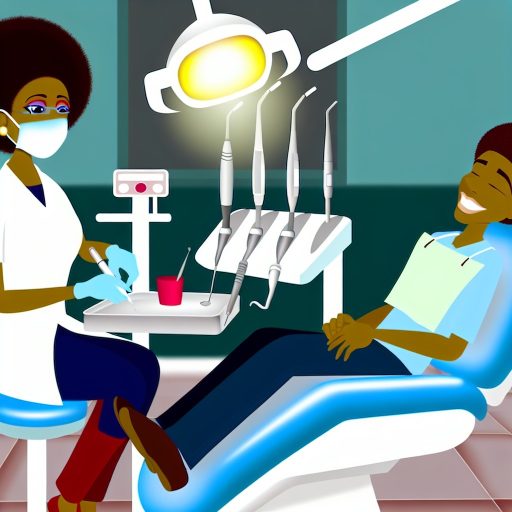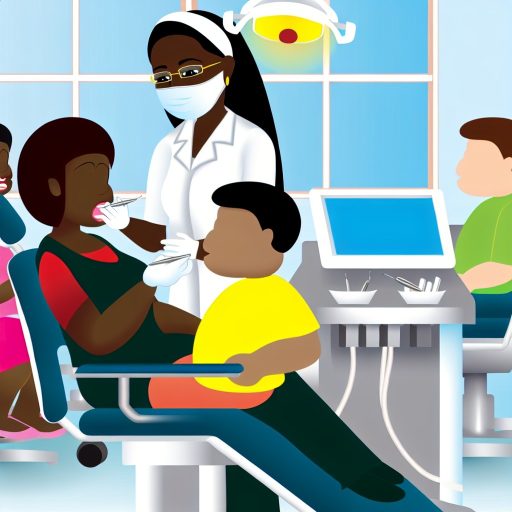Introduction:
When it comes to dental health, the cost of restorative procedures can be significant.
Many patients face challenges in affording dental care.
However, there are patient financing options available to help alleviate this financial burden.
Importance of Dental Health:
Ensuring good dental health is essential for overall well-being.
Neglecting oral health can lead to more serious issues in the future.
Restorative procedures are crucial for maintaining a healthy smile and preventing further damage.
Cost Associated with Restorative Procedures:
Restorative dental procedures such as fillings, crowns, and implants can be expensive.
The cost of these treatments can vary depending on the complexity of the case.
Patients may find it challenging to cover these costs upfront.
Common Challenges Patients Face:
One of the common challenges patients face is the lack of dental insurance coverage.
Without insurance, the out-of-pocket costs for procedures can be overwhelming.
Some patients may delay or skip necessary treatments due to financial constraints.
Patient Financing Options:
Fortunately, there are patient financing options available to assist patients in managing the cost of dental restorations.
These options allow patients to spread out the payments over time, making the treatments more affordable.
Examples of patient financing options include in-house financing plans offered by dental practices, third-party financing companies, and healthcare credit cards.
These options provide flexible repayment terms and low or no-interest financing.
This makes it easier for patients to budget for their dental care.
By utilizing patient financing options, patients can access the dental treatments they need without breaking the bank.
It’s essential for individuals to explore these options and discuss them with their dental provider to find a solution that fits their specific financial situation.
Overview of Dental Restoration Procedures:
There are various types of dental restorations, including fillings, crowns, bridges, and implants.
Restoring and maintaining oral health is crucial for overall well-being and confidence.
Conditions like cavities, cracked or chipped teeth, missing teeth, and gum disease may require restorations.
Types of Dental Restorations:
-
Fillings: Used to fill cavities and prevent further decay.
-
Crowns: Cover a damaged tooth to restore its shape, size, and strength.
-
Bridges: Replace missing teeth by bridging the gap between healthy teeth.
-
Implants: Permanent solutions for missing teeth, surgically placed into the jawbone.
Benefits of Dental Restorations:
-
Improves oral health by preventing further decay and infection.
-
Restores the function of teeth for proper chewing and speaking.
-
Enhances the aesthetics of the smile and boosts self-confidence.
-
Prevents shifting of teeth and maintains overall oral structure.
Conditions Requiring Dental Restorations:
-
Cavities: Decay in the tooth enamel that needs to be filled with fillings.
-
Cracked or Chipped Teeth: May require crowns or veneers for restoration.
-
Missing Teeth: Bridges or implants can replace missing teeth for improved function.
-
Gum Disease: Advanced gum disease may lead to tooth loss and require restorations.
By understanding the different types of dental restorations and the benefits they offer, patients can make informed decisions about their oral health care.
It’s essential to address any issues promptly to prevent further complications and maintain a healthy smile.
Cost of Dental Restorations:
Common dental restoration procedures can range from $500 to $3,000 per tooth.
Fillings typically cost between $100 to $500, depending on the material used.
Crowns can range from $800 to $3,000, based on the type of material used.
Variability in Cost:
Cost can vary based on the complexity of the procedure and the dentist’s expertise.
Porcelain veneers are more expensive than composite veneers due to material quality.
Inlays and onlays are pricier than fillings but more cost-effective than crowns.
Insurance Coverage Impact:
Insurance may cover a portion of the cost, typically ranging from 50% to 80%.
High-quality or cosmetic procedures may not be fully covered by insurance.
Patients should check with their insurance provider to understand coverage limits.
Discover More: Career Paths in Radiological Science in Nigeria
When it comes to paying for dental restorations, patients have several traditional payment methods available to them.
Traditional Payment Methods:
- Cash: Paying for dental restorations with cash is a straightforward and convenient option for many patients.
- Credit Cards: Credit cards offer patients the flexibility to pay for dental procedures over time.
- Personal Loans: Some patients choose to take out personal loans to cover the cost of dental restorations.
While traditional payment methods can be useful for covering routine dental expenses, they may have limitations when it comes to high dental costs.
High dental costs can quickly add up, especially for complex restorative procedures such as dental implants or full mouth reconstructions.
Patients may find that using cash or credit cards to pay for these treatments can be financially burdensome.
Personal loans, while offering a way to spread out payments, may come with high interest rates or strict repayment terms.
This can make it challenging for some patients to afford the monthly payments on top of other financial obligations.
Transform Your Career with Expert Guidance
Get personalized mentorship consulting that’s tailored to your unique path. Our expert advice is actionable and exclusive.
Get StartedGiven the limitations of traditional payment methods for covering high dental costs, it is essential for patients to explore alternative financing options.
Find Out More: Role of Culture in Nigerian Mental Health Practices
Patient Financing Options
When it comes to dental restorations, the cost can sometimes be a barrier for patients.
Fortunately, there are several patient financing options available to help make these treatments more affordable.
Here are some options to consider:
Dental Credit Cards
Dental credit cards are a type of credit card specifically designed for dental expenses.
These cards often have promotional financing offers, such as no interest if paid in full within a certain period.
- Special financing options
- No interest promotions
- Low monthly payments
In-House Payment Plans
Some dental offices offer in-house payment plans to help patients spread out the cost of their treatment over time.
These plans typically require a down payment and monthly installments.
- Convenient payment schedule
- No credit check required
- Customized plans to fit your budget
Third-Party Financing Companies
Third-party financing companies, such as CareCredit and LendingClub, specialize in healthcare financing, including dental procedures.
These companies offer flexible payment plans and low-interest rates.
- Wide acceptance at healthcare providers
- Ability to finance entire treatment cost
- Quick and easy application process
How these Options Work
Each financing option works differently but ultimately aims to make dental treatments more accessible and affordable for patients.
Dental credit cards provide special financing terms, in-house payment plans allow for customized payment schedules, and third-party financing companies offer flexibility and low rates.
Benefits for Patients
Choosing the right financing option can have several benefits for patients.
It can help them manage the cost of their treatment, access the care they need when they need it, and avoid delaying necessary dental work due to financial constraints.
Tips for Choosing the Best Financing Option
When selecting a financing option for your dental restoration, consider these tips to find the best fit for your individual needs and financial situation:
- Compare interest rates and fees
- Understand the terms and conditions
- Check if your preferred provider accepts the financing option
- Review the repayment schedule and monthly payments
- Ask about any promotional offers or discounts
By exploring the different patient financing options available, you can find a solution that works for you and helps you achieve optimal oral health without breaking the bank.
See Related Content: Key Haematology Labs and Services in Nigeria

Pros and Cons of Patient Financing:
When it comes to dental restorations, patient financing options can be a game-changer for many individuals.
Let’s take a closer look at the advantages and potential drawbacks of using patient financing for dental treatments.
Advantages of Patient Financing:
- Making treatment more affordable: One of the most significant benefits of patient financing is that it allows individuals to get the dental care they need without the burden of a large upfront cost.
- Flexible payment plans: Patient financing often provides flexible payment options, allowing patients to spread out the cost of their treatments over time.
- Immediate treatment: With patient financing, patients can get the treatment they need right away, without having to delay care due to financial constraints.
- Interest-free options: Some patient financing plans offer interest-free periods, allowing patients to pay for their treatments without incurring additional costs.
- No impact on credit score: Unlike traditional loans or credit cards, patient financing options may not have a negative impact on the individual’s credit score.
Potential Drawbacks of Patient Financing:
- Accruing interest: One of the main disadvantages of patient financing is that it can result in accruing interest over time.
- Impact on credit score: While some patient financing options may not affect credit scores, others may report to credit bureaus.
- Additional fees: Some patient financing plans may come with additional fees or hidden charges.
- Limited options: Not all dental practices offer patient financing, limiting the choices available to patients.
- Long-term commitment: Committing to a patient financing plan is a long-term financial obligation.
Tips on How to Manage and Budget for Monthly Payments:
Managing monthly payments for dental treatments can help individuals stay on track with their finances and ensure they can afford their care in the long run.
Here are some tips to help manage and budget for monthly payments:
- Create a budget: Start by assessing your income, expenses, and financial goals to create a budget that includes your dental treatment payments.
- Set up automatic payments: Consider setting up automatic payments for your patient financing plan to avoid missing due dates.
- Cut back on unnecessary expenses: Look for areas where you can cut back on unnecessary expenses to free up extra funds for your dental treatment payments.
- Communicate with your dental provider: If you’re facing financial difficulties, don’t hesitate to communicate with your dental provider.
- Monitor your progress: Keep track of your monthly payments and monitor your progress towards paying off your dental treatment.
Patient financing can be an excellent option for individuals seeking dental restorations without having the means to pay upfront.
By understanding the pros and cons of patient financing and implementing strategies to manage their payments effectively, patients can access the care they need.
Delve into the Subject: Training Programs for Obstetricians in Nigeria
Case Studies:
One patient, Sarah, struggled to afford a dental restoration after a sports injury.
She opted for a financing plan, allowing her to pay in manageable installments.
The financing made it possible for Sarah to get the treatment she needed.
As a result, Sarah’s smile was restored, and she regained confidence.
Another case is John, who needed multiple dental implants for missing teeth.
Despite insurance coverage, John still faced a significant out-of-pocket cost.
With a financing option, John was able to proceed with the implant procedure.
After completing treatment, John experienced a drastic improvement in his oral health.
Both Sarah and John’s stories highlight the importance of patient financing options.
These options enable patients to access necessary dental care without financial barriers.
Moreover, the successful outcomes demonstrate the positive impact of utilizing financing.
These case studies illustrate:
- The critical role patient financing plays in helping individuals afford dental restorations.
- The positive impact of financing on patients’ ability to receive essential dental treatments.
- The significant improvement in oral health and overall well-being post-treatment due to financing options.
Importance of Patient Financing Options for Dental Care
Patient financing options for dental restorations are crucial for individuals seeking affordable ways to get necessary dental care.
Exploring these options can help patients find solutions that work best for their financial situations.
It is important to prioritize oral health and not delay dental treatments due to cost concerns.
By seeking out affordable financing solutions, patients can ensure they receive the care they need without compromising their financial stability.
There are various financing options available, such as payment plans, dental credit cards, and loans.
These options can make dental restorations more accessible.
Don’t hesitate to explore these options and find a solution that suits your needs.




